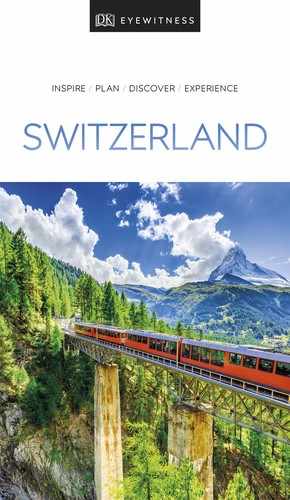Experience More
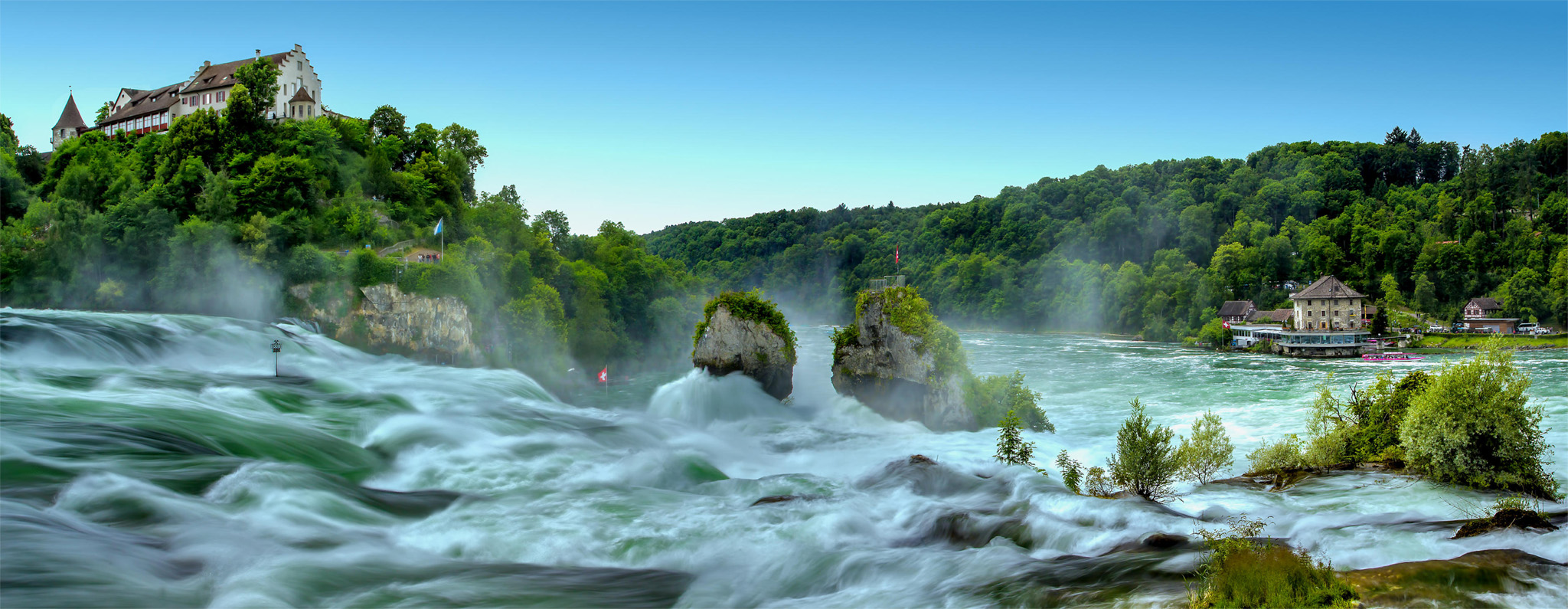
t Europe’s largest waterfall, the Rheinfall, overlooked by pretty Schloss Laufen
Creating an awe-inspiring spectacle of rainbow-tinted spray, the waters of the Rhine tumble off a cataract at Neuhausen, 4 km (2.5 miles) downriver from Schaffhausen. The waterfall, known as the Rheinfall, is the largest in Europe. Although it is only 23 m (75 ft) high, it is remarkable for its width (about 150 m/ 492 ft) and its beautiful setting between tree-covered banks.Schloss Laufen, a turreted Renaissance castle overlooking the river from the south, has the best view of the falls. From the castle, steps lead down to viewing platforms. A spectacular fireworks display is staged at the Rheinfall during the evening of 31 July, the eve of National Day (1 August), each year.

Picture Perfect
Behind the Falls
Capture the full majesty of the Rheinfall on a boat trip. Leaving from nearby Schaffhausen, tours stop at a mighty rock standing virtually in the middle of the falls, where platforms let you feel the vibration of the water as you snap the torrents up close.
Located on the River Murg, west of Bodensee, Frauenfeld is the capital of Thurgau canton. It is a picturesque town with attractive burgher houses in its historic centre, including the Baliere in Kreuzplatz, a half-timbered building that is now an art gallery, and the Luzemhaus, a Baroque building that houses a natural history museum. The origins of Frauenfeld’s castle go back to the 13th century. Its restored rooms house the Thurgau History Museum, a museum of local history. At Ittingen, located about 4 km (2.5 miles) north of Frauenfeld, is the Kartause Ittingen, a Carthusian monastery founded in the 15th century. No longer inhabited by monks, the monastery is open to visitors. As well as a hotel, a restaurant and a farm shop, the monastery also has a museum illustrating monastic life and a gallery of 20th-century Swiss painting.
The Bodensee, also known as Lake Constance, has become a summer playground for visitors attracted by the sailing, swimming and development of resort hotels along the shores. There is a wealth of water sports, including sailing and paddle-boarding. There are 337 km (209 miles) of protected bike trails touching four borders: Switzerland, Austria, Germany, and Liechtenstein. The massive lake, which is both fed and drained by the Rhine, is 64 km (40 miles) long and 12 km (7 miles) wide. Its western and southern shores, which belong to Switzerland, are lined with small resorts that have excellent fishing and watersports facilities. Kreuzlingen is the principal Swiss town here, with the Baroque Kirche St Ulrich its finest building. Schloss Arenenberg and the medieval castle of Gottlieben are both on the Swiss shoreline, as is the 14th-century Turmhof fortification in Steckborn.
With its numerous medieval half-timbered buildings and 16th-century houses with frescoed façades, Stein am Rhein is one of the country’s most beautiful sights. Founded in Roman times, this small town began to prosper and expand in the late 11th century, when German emperor Heinrich II established a Benedictine monastery here. The outline of the town walls can be made out, and two of the town gates, Obertor and Untertor, still stand. The main square, Rathausplatz, is lined with handsome wood-framed houses painted with motifs reflecting their names, such as House of the Sun or House of the Red Ox. The Lindwurm Museum re-creates 19th-century middle-class life over four floors of a beautifully restored house in the historic Old Town.
Overlooking the Rhine stands Kloster St Georgen, a Benedictine monastery, and its 12th-century church. The well-preserved monastery rooms, decorated in the early 16th century, now house the Klostermuseum St Georgen, devoted to local history.

t The cobbled Rathausplatz, with its fine medieval buildings, in Stein am Rhein
Lindwurm Museum
" ⌂ Understadt 18 ∑ museum-lindwurm.ch
Klostermuseum St Georgen
" ⌂ Fischmarkt 3 ∑ klostersanktgeorgen.ch
The Rhaetian railway
Riding a mountain train when in Switzerland is almost an inevitability. The most scenic line is the private Rhaetian Railway, running across 383 rail bridges and through 84 tunnels. Its Albula/Bernina Line, climbing up the Albula Valley past the dramatic Landwasser viaduct, is now a UNESCO World Heritage Site and one of Europe’s truly great rail journeys.
Surrounded on all sides by the canton of St Gallen, the region known as Appenzell consists of two half-cantons, Appenzell-Ausserrhoden in the north and west, and Appenzell-Innerrhoden in the south. From the 10th to the 15th centuries, Appenzell formed part of the territory owned by the abbey at St Gallen. Having gained its independence, Appenzell joined the Swiss Confederation in 1513.
While the bigger Appenzell-Ausserrhoden is Protestant and largely industrialized, Appenzell-Innerrhoden is Catholic and markedly more bucolic, with a farming economy and a developed tourist industry. It is renowned for its cattle-breeding and its dairy products, most especially its cheeses. Along with its rural character, Appenzell-Innerrhoden has strong folk traditions and a pristine natural environment.
Like many other towns in the region, Appenzell, capital of Innerrhoden, has a Landsgemeindeplatz, a square on which regular voting sessions are held. The well-preserved historic centre of this small town is filled with colourfully painted wooden houses. Also of interest are the 16th-century town hall and the parish church, Kirche St Mauritius, which was built in the 16th century in the Baroque style and remodelled in the 19th century.
The history and culture of Appenzell is amply documented by the varied and extensive collections of the Museum Appenzell. These range from costumes and headdresses to embroidery and cowbells.
To the south of Appenzell lies the Alpstein massif. The highest peak here, the Säntis, rises to 2,504 m (8,215 ft). Popular with hikers and mountaineers, the Säntis can be reached by road or by cable car from Schwägalp.
The picturesque village of Urnäsch, in Ausserrhoden, also has the Appenzeller Brauchtumsmuseum, a folk museum. Its collection includes reconstructed farmhouse interiors, as well as costumes and craft items. North of Urnäsch lies Herisau, capital of the canton of Appenzell-Ausserrhoden. The town boasts attractive wooden houses and a church with Rococo furnishings dating from 1520.
Stein, a quiet village east of Herisau, has an interesting folk museum and show dairy. While the displays at the Appenzell Folklore Museum illustrate the lives, culture and crafts of the local people, at the Appenzeller Showcase Dairy (Schaukäserei), visitors can watch cheese being made using local methods.
The market town of Gais, at the centre of Appenzell, is of interest for its colourfully painted wooden houses, many of which have ornate gables. It is also an excellent base for exploring the region.

t A beautifully decorated bed on display in the Museum Appenzell
Museum Appenzell
" ⌂ Appenzell, Hauptgasse 4 # Apr–Oct: 10am–noon & 2–5pm daily; Nov–Mar: 2–5pm Tue–Sun ∑ museum.ai.ch
Appenzeller Brauchtumsmuseum
" ⌂ Urnäsch # Apr–Oct: 9–11:30am & 1:30–5pm Mon–Sat, 1:30–5pm Sun; Nov–Mar: 9–11:30am Mon–Sat ∑ museum-urnaesch.ch
Appenzell Folklore Museum
" ⌂ Stein # 10am–5pm Tue–Sun ∑ appenzeller-museum-steinach
Appenzeller Showcase Dairy (Schaukäserei)
' ⌂ Stein # May–Oct: 9am–6:30pm daily; Nov– Apr: 9am–5:30pm daily ∑ schaukaeserei.ch

Insider Tip
Appenzell Whisky Trek
Alpine paths connect 25 mountain inns across Alpstein. In each, barrels of individually distilled alpine malts can be sampled and collected in bottles signed by the cask keeper (www.appenzellerbier.ch).
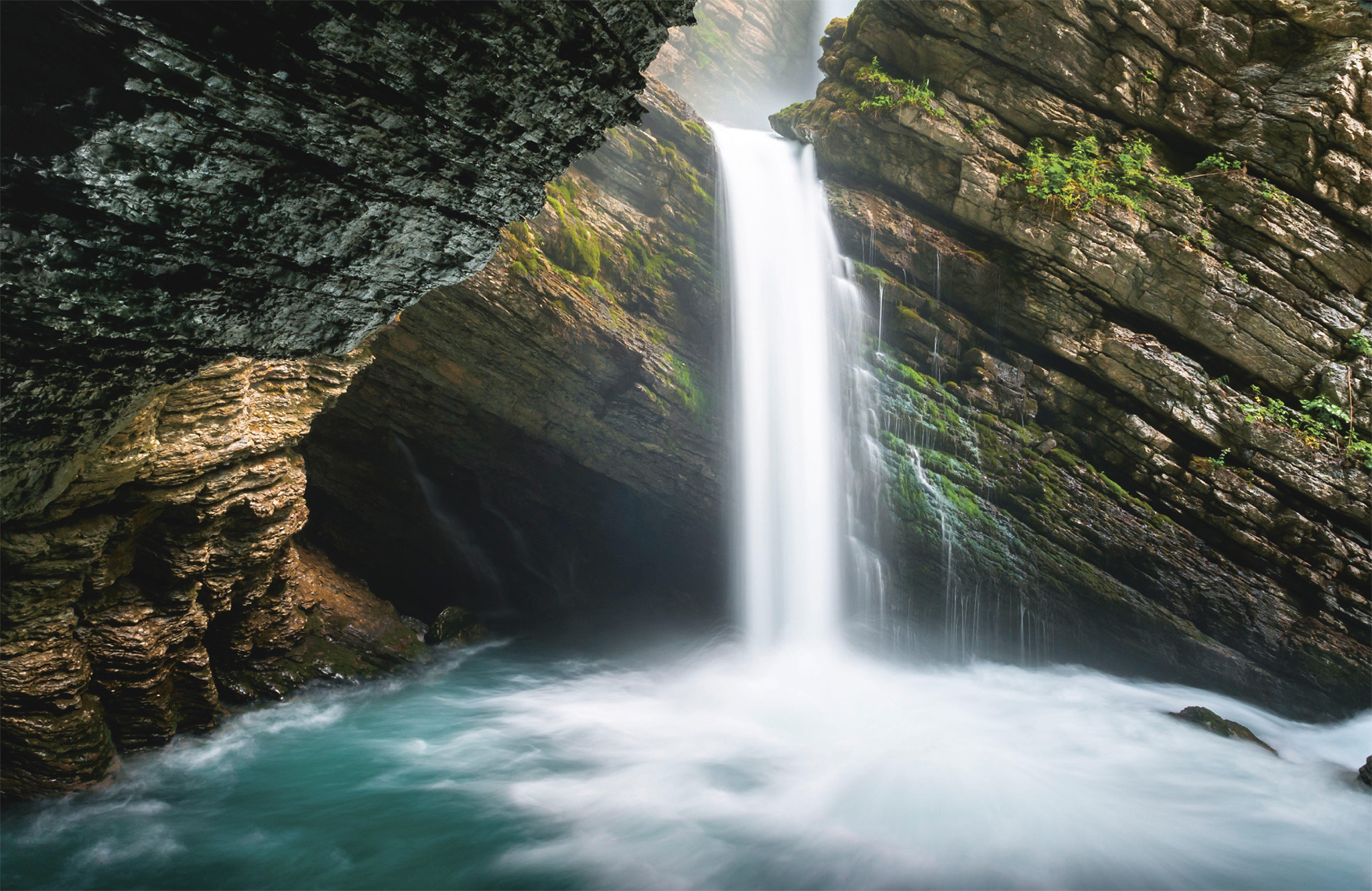
t The impressive cascade of the Thurwasserfälle at Unterwasser
Washed by the River Thur, the Toggenburg is a long valley that lies on a north-south axis between Wil and Wattwil, then veers eastwards just above Alt St Johann, where it becomes Oberes Toggenburg, which then opens out onto the Rhine valley.
The Toggenburg has over 300 km (185 miles) of marked hiking and cycling trails, and its gentle slopes provide easy skiing pistes. The valley is dotted with attractive small towns and villages, among them are Wil and Lichtensteig, which has historic houses.
Wildhaus, a pleasant resort at the eastern extremity of Oberes Toggenburg, is the birthplace of Ulrich Zwingli, the leader of the Reformation in Switzerland. The farmhouse where he was born in 1484 is open to visitors. Unterwasser is worth a visit too, for its impressive waterfall, the Thurwasserfälle.

t An attractive rose garden in a courtyard of Rapperswil’s medieval castle
This small town, in the canton of St Gallen, sits on a promontory on the north side of the Zürichsee. Although the modern part of Rapperswil has nothing of great interest, the traffic-free medieval centre is a pleasant place to stroll. Behind the lakeside promenade lie narrow streets lined with houses fronted by arcades, and small squares with cafés and restaurants serving fresh locally caught fish. From May to October the air is filled with the delicate perfume of more than 15,000 roses. Known as the City of Roses, Rapperswil has more than 16,000 roses flowering in walled gardens, including one within a Capuchin monastery and a particularly serene one specially designed for the visually impaired and those with mobility issues.
Besides the 15th-century town hall and the parish church, Rapperswil’s main feature is its looming Gothic castle, whose three forbidding towers rise above the town. From the castle there are views of Zürich to the north and of the Glarus Alps to the southwest. The village makes a good base for hiking in summer and skiing in winter.
Did You Know?
Rapperswil-born Marianne Ehrmann was one of the first German-speaking female writers.

t The small port of Weesen in an idyllic lakeside setting on the Walensee
This slender lake marks the border between the cantons of St Gallen and Glarus. About 15 km (9 miles) long and just 2 km (1 mile) across at its widest point, it lies in a steep-sided valley, with the rugged Churfirsten massif on its northern side and the Glarner Alps to the southeast. This lovely region is also known as Heidiland after Johanna Spyri’s famous children’s novel.
The railway line and the motorway linking Zürich and Chur run along the south side of the lake. Most of the towns and villages on the steep north shore are accessible only by boat or on foot. Cruises on the lake take in the charming town of Weesen.
A short distance south is Näfels, which boasts a late-Renaissance palace, the Freulerpalast. The building houses a museum of local history. The neighbouring town of Mollis contains well-preserved burgher houses and fine 18th-century mansions, while Walenstadt, on the lake’s eastern shore, is a convenient base for exploring the mountains, including Walenstadtberg and Berschis.
Bad Ragaz, set on the River Tamina, is one of Switzerland’s foremost spa resorts, with grand old palace-style hotels and an outstanding golf course. Its natural thermal springs have been used to cure ailments since the 13th century. The resort has several indoor and outdoor pools – Tamina-Therme, in the centre of the resort, is the best known.
Bad Ragaz also has an early 18th-century parish church with Baroque wall paintings. The town hall contains a display of paintings and other works of art of Bad Ragaz and its environs. As well as skiing on the slopes of Pizol, Bad Ragaz offers golf, tennis and other sporting activities. It is also an excellent base for hiking in the surrounding hills.
About 5 km (3 miles) south of Bad Ragaz is Bad Pfäfers, a spa town with a beautiful Baroque church and a former Benedictine monastery that houses a local history museum.
Southwest of Bad Ragaz is the Taminaschlucht, a deep gorge carved out by the rushing waters of the Tamina. Also of interest is Sargans, which has beautiful Neo-Classical buildings and a Gothic castle.
1535
The year Swiss doctor Paracelsus recognized the healing powers of Bad Pfäfers’ hot springs.
The village of Maienfeld, across the Rhine from Bad Ragaz, is also part of the Heidiland tourism area. It was this part of the Swiss Alps that Johanna Spyri chose as the setting for Heidi (1881), the story of an orphaned girl that has become a classic of children’s literature. A very easy walking trail leads from Maienfeld up to the hamlet of Oberrofels. Here visitors can see Heidi’s House, a wooden chalet in which the fictional surroundings of Heidi’s life with her grandfather are vividly re-created.
Originally a remote village, Davos developed into a health resort for tuberculosis sufferers in the 1860s, and was transformed into a winter sports resort in the 1930s. Today it is one of the largest of Swiss resorts and hosts world leaders at the Davos World Economic Forum.
Davos has close associations with German writer and Nobel laureate Thomas Mann, who visited in 1911 and was inspired to write The Magic Mountain. The town is also associated with the German Expressionist painter Ernst Ludwig Kirchner, who settled here in 1917. The largest collection of his work in the world, including many of the alpine landscapes that he painted during his years in Davos, are displayed in the Kirchner Museum here.
Davos has some famous “off-piste” powder snow runs, but beginners are catered for, too: there are several ski and snowboarding schools, as well as some less demanding slopes. There are also toboggan runs and a large natural ice rink, where ice hockey is played.
In summer visitors can enjoy golf and tennis, hiking along trails, rock climbing and trekking on horseback.
Kirchner Museum
" ⌂ Promenade 82 # 11am–6pm Tue–Sun ∑ kirchnermuseum.ch
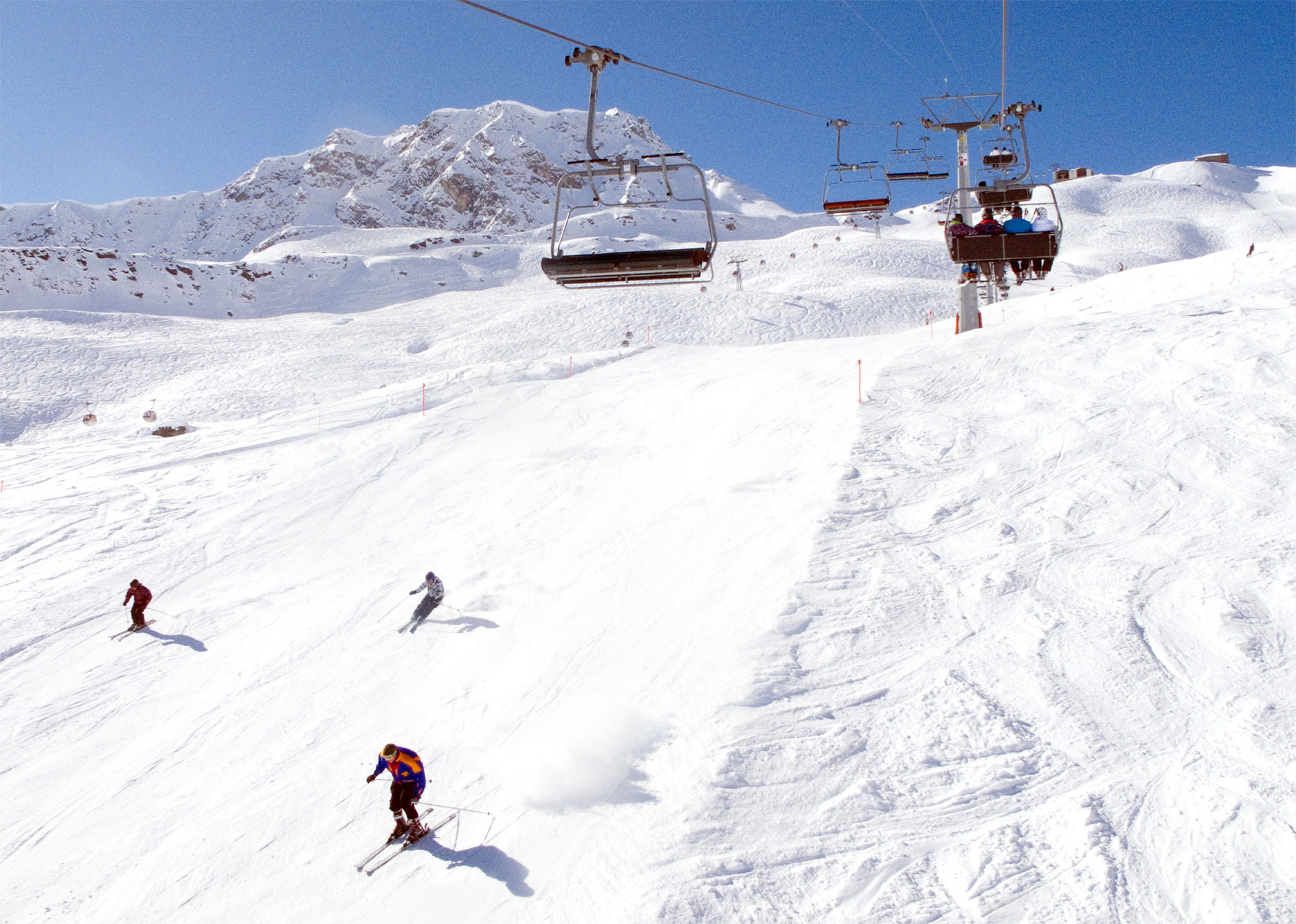
t The slopes of the Hörnli near Arosa, ideal for intermediate skiiers
Set in a bowl in the narrow Schanfigg valley, Arosa is one of Switzerland’s most beautiful resorts. Although it lies at an altitude of 1,800 m (5,900 ft), it enjoys a gentle climate, with lots of sunshine.
The town is divided into two areas. Ausserarosa is the main resort and Innerarosa the original village. The crafts and folk art on display in the Schanfigg Heimatmuseum reflect mountain life in the days before the town became a popular winter holiday spot.
In winter the neighbouring slopes of Weisshorn, Hörnli and Prätschli provide superb downhill pistes. There are also cross-country trails, a sleigh run and an ice rink. In summer visitors can enjoy over 200 km (125 miles) of hiking trails and mountain biking routes, and the resort’s two lakes offer a variety of watersports.
Schanfigg Heimatmuseum
" ⌂ Poststrasse, Innerarosa # Jun–Oct: 2:30–4:30pm Mon, Wed & Fri; Dec–Apr: 2:30–4:30pm Tue & Fri ∑ arosa-museum.ch
The Engadine Valley is generally acknowledged as one of Switzerland’s most scenic. It begins at the foot of the Rhaetian Alps, near St Moritz, and extends northeastwards as far as the border of Austria. It is named after the River Inn (En in Romansh), which runs along the valley and on into Austria, where it joins the Danube.
This deep valley between high cliffs is divided into an upper, southwestern section and a lower, northeastern section. The Upper Engadine (Oberengadin in German, Engiadin’ Ota in Romansh) lies between the Maloja Pass and Zernez. With glaciers and snowy peaks on either side, the valley floor of the Upper Engadine lies at an altitude averaging 1,800 m (5,900 ft) and is dotted with several popular winter sports resorts, including Pontresina and St Moritz.
The Lower Engadine (Unterengadin in German, Engiadina Bassa in Romansh) lies between Zernez and Martina. Remote, unspoiled and very picturesque, this region is dotted with attractive villages set on either side of the River Inn. Many of these villages have houses with painted façades or sgraffito decoration, in which the upper layer of plaster is cut away to create a design. Particularly fine sgraffito decoration can be seen in Guarda, a village overlooking the River Inn. The village of Ardez is also notable for its painted houses, one of which has an exterior covered with a beautiful depiction of Adam and Eve in the Garden of Eden.
The principal town of the Lower Engadine is Scuol (Schuls in German), with a spa and a regional museum. On the opposite bank of the Inn lie the villages of Vulpera, which has picturesque houses and an 11th-century castle, and Tarasp, with a spa. Chaste Tarasp, a castle, perches on a rocky spur above the village. At S-charl, nearby, is a lead and silver mine, which is open to visitors.
Most of the towns and villages in the Lower Engadine make good bases for exploring the Silvretta mountain range to the north and the Swiss National Park to the south.

t Hikers in the village of Ardez, notable for its houses painted with beautiful murals
Tucked away at the bottom of Val Müstair (Münstertal in German), and almost on the border with Italy, Romansh-speaking Müstair (Münster in German) takes its name from the Carolingian monastery founded here in about AD 780. The working convent is one of the oldest buildings in the country.
The convent church, known in Romansh as the Baselgia San Jon and in German as Klosterkirche St Johann, is a working convent decorated with exceptionally well-preserved 12th- and 13th-century Romanesque frescoes. Because of these, the church has been declared a UNESCO World Heritage Site. While the frescoes on the side walls depict scenes from the life of Christ, those in the presbytery show scenes from the life of St John. A depiction of the Last Judgement covers the west wall. Some of the frescoes have now been moved to the Schweizerisches Nationalmuseum in Zürich. The church also has a 12th-century statue of Charlemagne and an 11th-century relief of the baptism of Christ. The small museum near the church contains Carolingian statuary and Baroque figures.
Baselgia San Jon
" # Church: Apr–Oct: 7am–8pm daily, Nov–Mar: 7:30am–6pm daily; museum: May–Oct: 9am–5pm daily, Nov–Apr: 10am–noon & 1:30–4:30pm Mon–Sat, 1:30–4:30pm Sun ∑ muestair.ch
Cross-country skiing in the Engadine
Even more popular with Swiss families than downhill skiing is scuffling along the flats, through the woods and over the frozen lakes, on more than 230 km (142 miles) of trails in the Engadin Valley. When using long, narrow lightweight skis, sliding down even the slightest hill becomes a mini adventure.
A mountaineering resort since the 19th century, Pontresina, in the Upper Engadine, lies at the foot of Val Bernina at an altitude of 1,800 m (5,900 ft).
Among Pontresina’s historic buildings are the Spaniola Turm, a Romanesque tower, and the chapel of Santa Maria, containing Romanesque frescoes, some of which depict scenes from the life of Mary Magdalene. Exhibits in the Museum Alpin illustrate the history of the town.
Pontresina is a year-round resort. In winter the slopes of Diavolezza and Lagalb are linked into the 350-km (217-mile) network of the Engadine ski region. In summer, Pontresina offers gentle walking along wooded paths, as well as more demanding hiking and mountaineering up to the summits of Alp Ota and Munt della Bescha. The hiking trail up Val Roseg leads to a glacier at the foot of Piz Roseg. Experienced climbers can tackle Piz Bernina, at 4,049 m (13,284 ft) the highest peak in the Rhaetian Alps.
Museum Alpin
" ⌂ Via Maistra 199 § 081 842 72 73 # Mid-Jun–mid-Oct & end Dec–mid-Apr: 4–6pm Mon–Sat
Did You Know?
Legend has it a red-haired siren lured mountineers to their doom on Diavolezza.
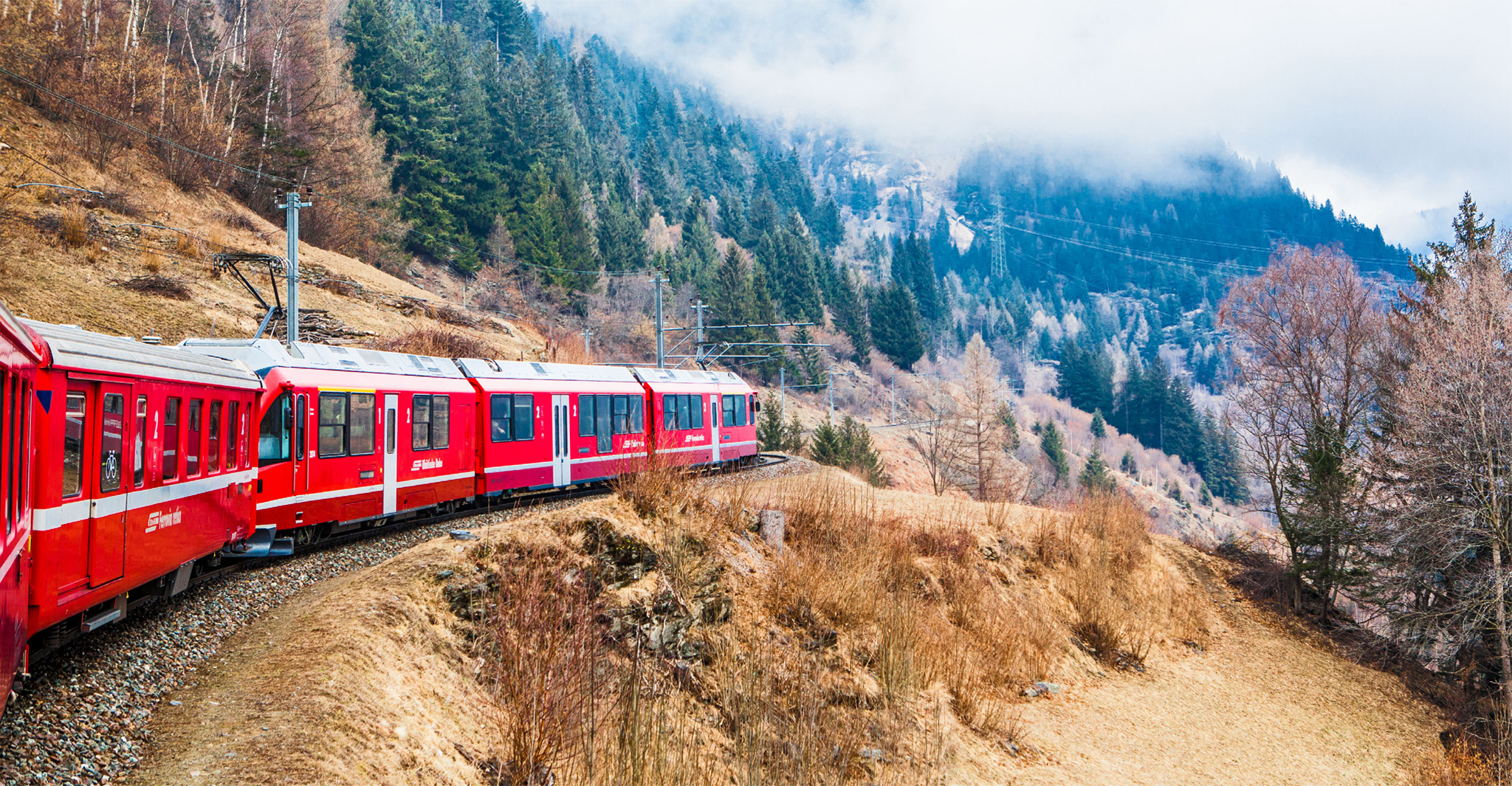
t The Bernina Express train making its dramatic ascent up to the Bernina Pass
At an altitude of 2,328 m (7,638 ft), the Bernina Pass is the highest point on the ancient route from St Moritz to Tirano, in Italy.
A road climbs up Val Bernina on the north side of the pass and descends Val di Poschiavo on its southern side. The pass is also served by ordinary trains and by the Bernina Express. The breathtaking view from the pass takes in the peaks of the Rhaetian Alps to the north and Lago Bianco, an artificial lake.

t The traditional Engadine village of Sils on the north shore of the Silersee
The western continuation of the Inn valley culminates at the Maloja Pass (1,815 m/ 5,955 ft), which marks the western boundary of the Engadine. On the western side of the pass a road winds down the canton’s predominantely Italian-speaking valleys.
Dotted with ruined castles and small churches, Val Bregaglia is popular with mountaineers for its many scenic hiking trails and extraordinary rock formations.
The main village in the valley is Vicosoprano, which has mansions and historic law courts. Further south lies Stampa, birthplace of the artists Augusto Giacometti and his son, Alberto. Their works can be seen in Stampa at the 16th-century Casa Granda, where there is also a museum of local history.
The charming hamlet of Soglio sits on the north side of the valley and is the starting point for numerous scenic hiking trails.
Food in St Moritz
Known as a foodie place in the snow, St Moritz has a buzzing culinary scene, with its share of celebrity chefs and Michelin stars. Central to its epicurean reputation is the town’s Gourmet Festival. Held every January, it entices gourmands with the chance to sample elaborate and inventive dishes cooked by master chefs, taste local delicacies from around the world and quaff award-winning wines.
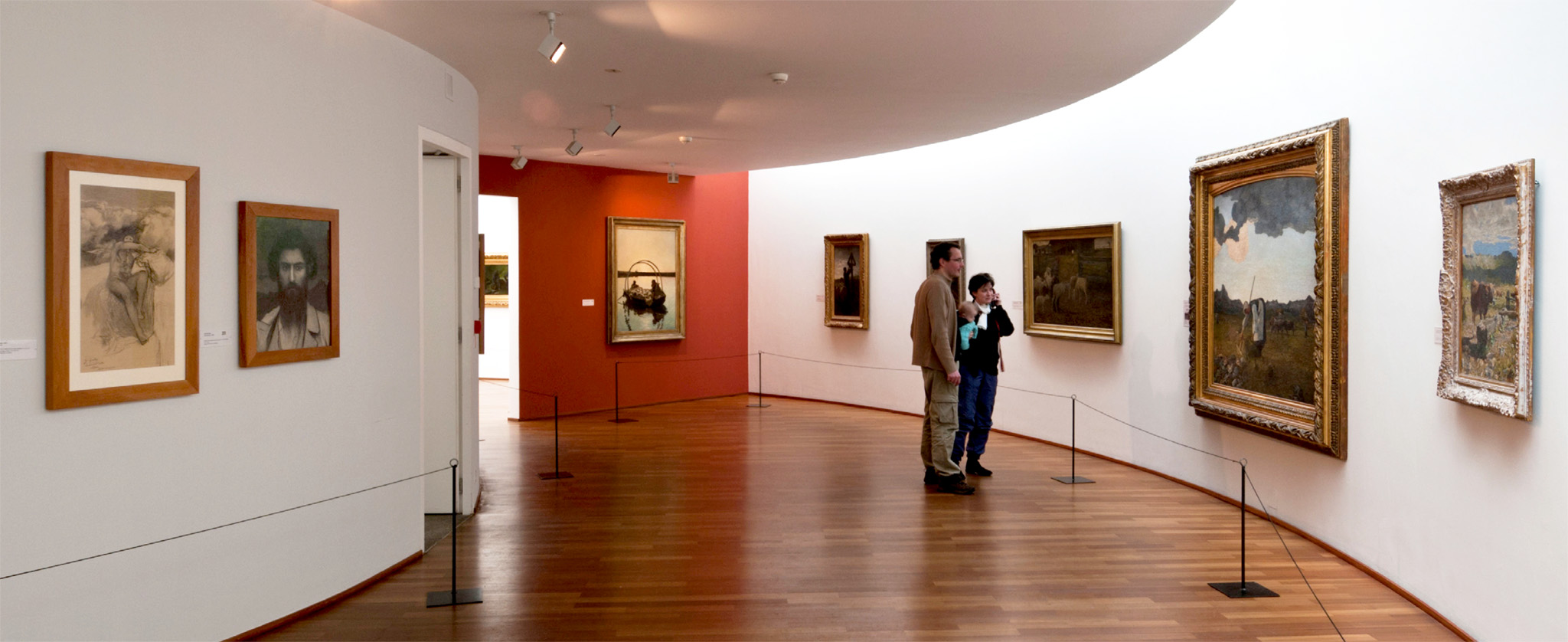
t Paintings displayed at the Giovanni-Segantini Museum, St Moritz
The birthplace of winter tourism, still celebrated for its “champagne atmosphere” at 1,800 m (5,900 ft), St Moritz (San Murezzan in Romansh) lies on a sunny terrace on the north shore of the Moritzersee. Surrounded by mountains, it offers superb skiing and snowboarding, and is a base for hiking and mountaineering in summer. Visitors will also find the world’s oldest and only natural-ice bobsled run here. It is also known for its curative springs, exploited at least since the Middle Ages.
The town has two districts: St Moritz-Bad, the spa area on the southwestern side of the lake, and St Moritz-Dorf, on the northern side, with hotels, restaurants and boutiques.
Although little remains of the original village, St Moritz is an interesting place with two diverting museums. The Giovanni-Segantini Museum, on Via Somplaz, is devoted to the Symbolist painter, who spent the final years of his life in the Upper Engadine. On Via dal Bagn, just below Via Somplaz, is the Museum Engiadinais, which looks at life in the Engadine and the history of the spa.
Giovanni-Segantini Museum
" ⌂ Via Somplaz 30 # Dec–Oct: 10am–noon & 2–6pm Tue–Sun ∑ segantini-museum.ch
Museum Engiadinais
" ⌂ Via dal Bagn 39 # 10am–noon & 2–5pm Mon–Fri & Sun ∑ museum-engiadinais.ch
75
The number of seconds it takes to zoom down the St Moritz bobsled run.
The charming village of Sils (Segl in Romansh) has a picturesque setting on the north shore of the Silsersee. The village consists of two parts: Sils Baselgia, on the lakeshore, and Sils Maria, to the south. Many writers, painters and musicians have been drawn to Sils. From 1881 to 1889, Sils Maria was the summer residence of the German philosopher Friedrich Nietzsche. The house where he lived, and where he wrote Also Sprach Zarathustra, has been converted into a small museum, the Nietzsche Haus.
Nietzsche Haus
" ' ⌂ Via da Marias 67 # Jan–mid-Apr & mid-Jun–mid-Oct: 3–6pm Tue–Sun ∑ nietzschehaus.ch
In the village of Zillis (Ziràn in Romansh), a remarkable cycle of Romanesque frescoes adorn a small church, on the east bank of the Hinterrhein.
The wooden ceiling of Kirche St Martin is covered with 153 square panels, painted between 1109 and 1114. The exterior panels depict an ocean filled with sea monsters; those in the interior show scenes from the life of Christ and of St Martin.
Kirche St Martin
⌂ Am Postplatz § 081 661 22 55 # 8am–6pm daily (Nov–Mar: from 9am)
On the great transalpine route running from Bodensee, in the far northeast of the country, down to Lake Como, in Italy, San Bernardino is one of Europe’s most important mountain passes, lying at an altitude of 2,066 m (6,778 ft). Although snow usually blocks the pass from November to May, the 7-km (4-mile) tunnel beneath it is permanently open. The village resort of San Bernardino, located on the south side of the pass, makes an excellent base for hiking and exploring the surrounding mountains.
Experience Eastern Switzerland and Graubünden
|
Stay Suvretta House St Moritz Imeccable service and Alpine luxury perched high above the Engadine Valley. F5 ⌂ Chasellas, Via 1 ∑ suvrettahouse.ch |

t A spectacular waterfall near the Klausen Pass in the canton of Glarus
Capital of the canton of Glarus, this small town is also the urban centre of Glarnerland, a rather isolated and mountainous but beautiful region that lies between the Walensee and the Klausen Pass. Largely rebuilt after it was destroyed by fire in 1861, the town is laid out on a grid pattern and as such is a classic example of 19th-century urban planning. Notable buildings here include the town hall, the Kunsthaus Glarus – an art gallery with a collection of 19th- and 20th-century Swiss paintings – and the Neo-Romanesque parish church with a treasury that contains a collection of liturgical vessels.
With beautiful lakes and valleys, the mountains around Glarus, particularly those of the Glärnisch massif, are popular with hikers. Many of the slopes have excellent pistes. South of Glarus, the main road goes on to Linthal, from where a funicular climbs to Braunwald. This tranquil car-free resort is set on a plateau that offers superb hiking. Beyond Linthal the road leads through some spectacular scenery over the Klausen Pass (1,948 m/6,391 ft) and down to Altdorf and Lake Lucerne.
Did You Know?
Klosters is known as “Hollywood on the Rocks” because it attracts so many celebrities.
Quieter and smaller than Davos, its neighbour to the south, the discreetly chic ski resort of Klosters has an intimate atmosphere. The only remaining trace of the medieval monastery from which it takes its name is Kirche St Jacob, which has beautiful stained-glass windows by Augusto Giacometti. The history of the village and its development into a resort are documented by displays in the Nutli-Hüschi, a 16th-century chalet.
Klosters shares a skipass region with Davos, encompassing 320 km (199 miles) of ski terrain. It is suitable for all levels of experience, from beginner to master skier.
Nutli-Hüschi
" ⌂ Talstrasse # 3–5pm Wed & Fri ∑ museum-klosters.ch

t Poschiavo’s central square with its Italianate buildings
The descent down Val di Poschiavo, the valley on the south side of the Bernina Pass, reveals a very different side of Switzerland. Here the climate and vegetation, as well as the language and the culture, are Mediterranean. Buildings show an Italian influence, the cuisine turns to pastas and antipasti, and cypress trees and palms grow in sheltered gardens.
Poschiavo (Puschlav in German) is the main town in the valley. At its heart is the Piazza Communale, a square lined with Italianate palazzi and two churches, a late 15th-century Catholic church and a 17th-century Protestant church. Other notable buildings include the Casa Torre, a Romanesque tower, and the Palazzo Albricci. The so-called Spaniolenviertel (Spanish Quarter) boasts imposing houses painted in a colourful Moorish style.
At nearby Cavaglia are remarkable geological features known as cauldrons. These are natural wells, up to 3 m (10 ft) in diameter, that were carved into the rock by the circular action of stones and water released by a melting glacier.
The picturesque stone houses of Mesocco cluster on the banks of the River Moesa, which runs along the Valle Mesolcina. This valley stretches from the San Bernardino Pass southwards to Bellinzona and, although it is located in the canton of Graubünden, it has strong cultural links with Ticino.
The Castello di Misox, a ruined fortress set on a rocky outcrop above the town, commands a stunning view of the valley and the villages in it. Built for the counts of Sax von Misox during the 12th century, the castle was significantly extended in the 15th century and in 1480 it passed into the ownership of the Trivulizio family, from Milan. The slender campanile is a remnant of the castle complex, which was almost completely destroyed in 1526.
At the foot of the castle stands the Romanesque church of Santa Maria del Castello. Built in the 12th century, the church was partly remodelled in the 17th century. The nave has a coffered ceiling, and the walls are decorated with well-preserved 15th-century murals, which depict St George and the Dragon, St Bernard of Siena, patron saint of Valle Mesolcina, and scenes symbolizing the months of the year.
About 4 km (2.5 miles) south of Mesocco is Soazza, a village with an attractive 17th-century church. About 15 km (9 miles) south of Soazza is the sleepy village of San Vittore, where there is an 8th-century chapel. The Val Calanca, which runs into Valle Mesolcina, is also well worth exploring for its beautiful scenery.
Experience Eastern Switzerland and Graubünden
|
Eat Chesa Grischuna Award-winning French cuisine in a grand chalet. ! F4/F5 ⌂ Bahnhofstrasse 12, Klosters ∑ chesagrischuna.ch La Marmite Fine wines and haute cuisine at high altitude. ! F5 ⌂ Corviglia, St Moritz § 81 833 63 55 |
